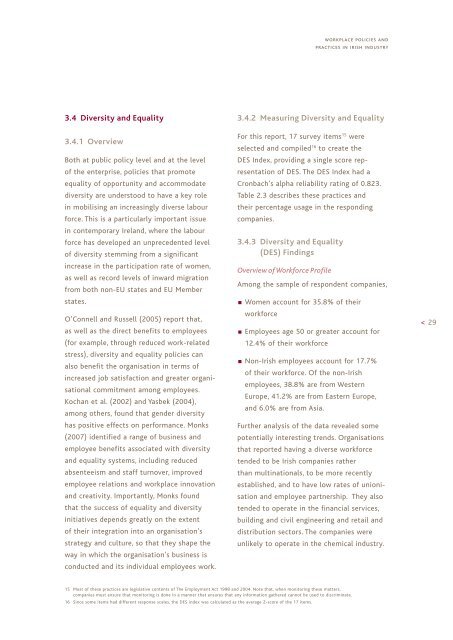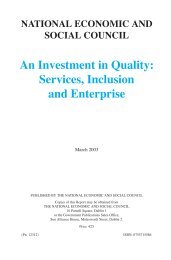New Models of High Performance Work Systems - Equality Authority
New Models of High Performance Work Systems - Equality Authority
New Models of High Performance Work Systems - Equality Authority
Create successful ePaper yourself
Turn your PDF publications into a flip-book with our unique Google optimized e-Paper software.
workplace policies and<br />
practices in irish industry<br />
3.4 Diversity and <strong>Equality</strong><br />
3.4.1 Overview<br />
Both at public policy level and at the level<br />
<strong>of</strong> the enterprise, policies that promote<br />
equality <strong>of</strong> opportunity and accommodate<br />
diversity are understood to have a key role<br />
in mobilising an increasingly diverse labour<br />
force. This is a particularly important issue<br />
in contemporary Ireland, where the labour<br />
force has developed an unprecedented level<br />
<strong>of</strong> diversity stemming from a significant<br />
increase in the participation rate <strong>of</strong> women,<br />
as well as record levels <strong>of</strong> inward migration<br />
from both non-EU states and EU Member<br />
states.<br />
O’Connell and Russell (2005) report that,<br />
as well as the direct benefits to employees<br />
(for example, through reduced work-related<br />
stress), diversity and equality policies can<br />
also benefit the organisation in terms <strong>of</strong><br />
increased job satisfaction and greater organisational<br />
commitment among employees.<br />
Kochan et al. (2002) and Yasbek (2004),<br />
among others, found that gender diversity<br />
has positive effects on performance. Monks<br />
(2007) identified a range <strong>of</strong> business and<br />
employee benefits associated with diversity<br />
and equality systems, including reduced<br />
absenteeism and staff turnover, improved<br />
employee relations and workplace innovation<br />
and creativity. Importantly, Monks found<br />
that the success <strong>of</strong> equality and diversity<br />
initiatives depends greatly on the extent<br />
<strong>of</strong> their integration into an organisation’s<br />
strategy and culture, so that they shape the<br />
way in which the organisation’s business is<br />
conducted and its individual employees work.<br />
3.4.2 Measuring Diversity and <strong>Equality</strong><br />
For this report, 17 survey items 15 were<br />
selected and compiled 16 to create the<br />
DES Index, providing a single score representation<br />
<strong>of</strong> DES. The DES Index had a<br />
Cronbach’s alpha reliability rating <strong>of</strong> 0.823.<br />
Table 2.3 describes these practices and<br />
their percentage usage in the responding<br />
companies.<br />
3.4.3 Diversity and <strong>Equality</strong><br />
(DES) Findings<br />
Overview <strong>of</strong> <strong>Work</strong>force Pr<strong>of</strong>ile<br />
Among the sample <strong>of</strong> respondent companies,<br />
p Women account for 35.8% <strong>of</strong> their<br />
workforce<br />
p Employees age 50 or greater account for<br />
12.4% <strong>of</strong> their workforce<br />
p Non-Irish employees account for 17.7%<br />
<strong>of</strong> their workforce. Of the non-Irish<br />
employees, 38.8% are from Western<br />
Europe, 41.2% are from Eastern Europe,<br />
and 6.0% are from Asia.<br />
Further analysis <strong>of</strong> the data revealed some<br />
potentially interesting trends. Organisations<br />
that reported having a diverse workforce<br />
tended to be Irish companies rather<br />
than multinationals, to be more recently<br />
established, and to have low rates <strong>of</strong> unionisation<br />
and employee partnership. They also<br />
tended to operate in the financial services,<br />
building and civil engineering and retail and<br />
distribution sectors. The companies were<br />
unlikely to operate in the chemical industry.<br />
< 29<br />
15 Most <strong>of</strong> these practices are legislative contents <strong>of</strong> The Employment Act 1998 and 2004. Note that, when monitoring these matters,<br />
companies must ensure that monitoring is done in a manner that ensures that any information gathered cannot be used to discriminate.<br />
16 Since some items had different response scales, the DES index was calculated as the average Z-score <strong>of</strong> the 17 items.
















